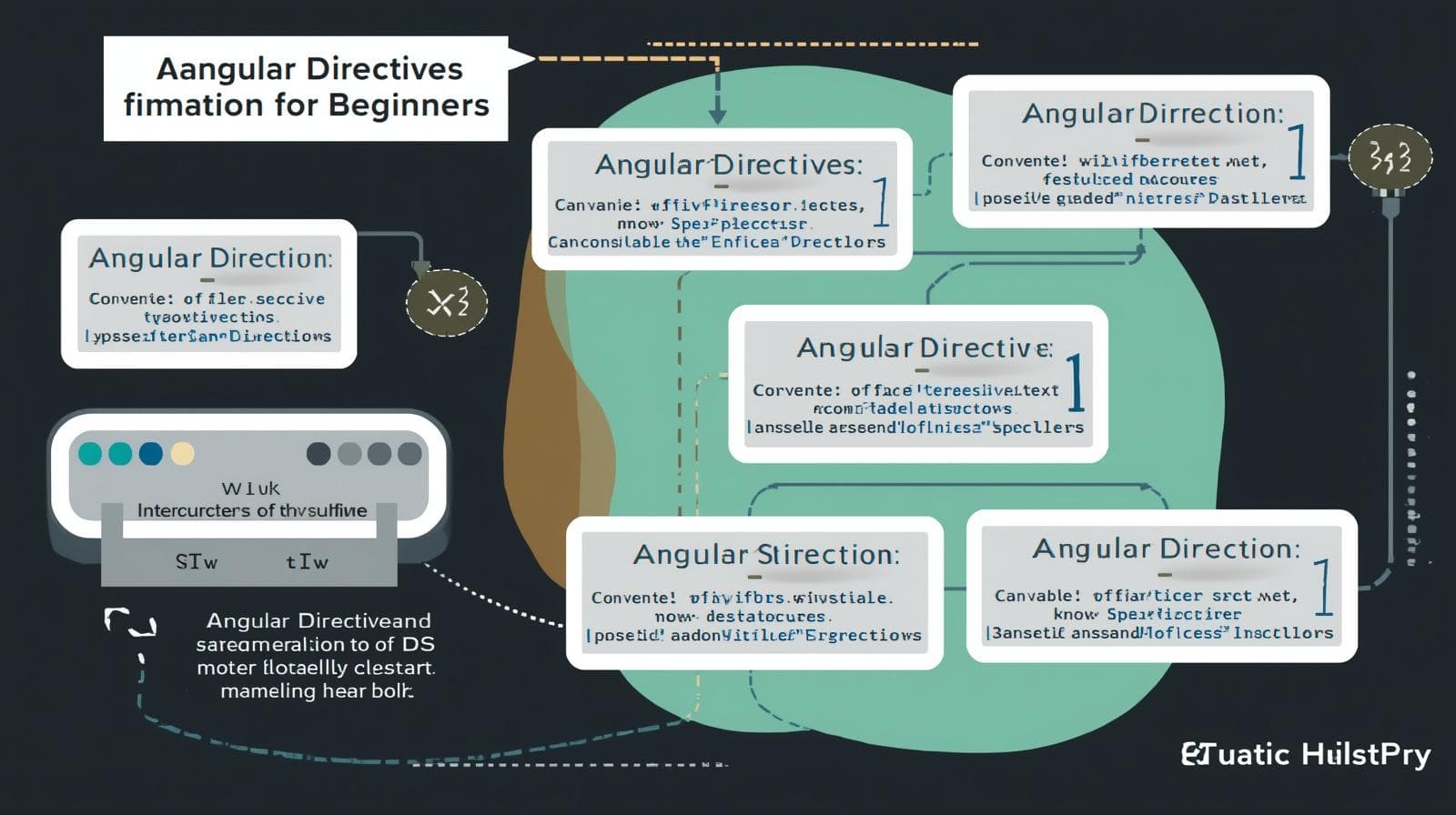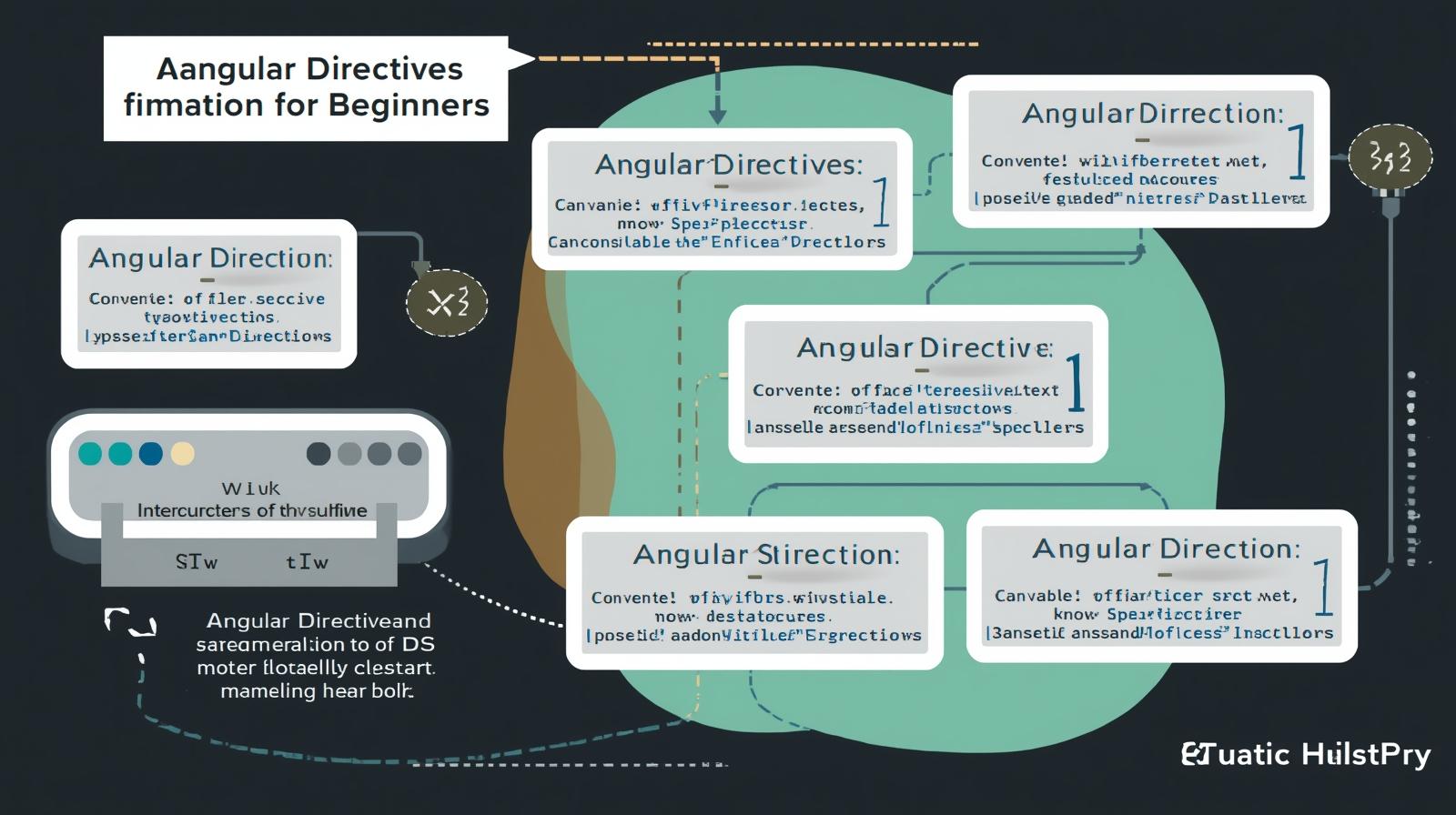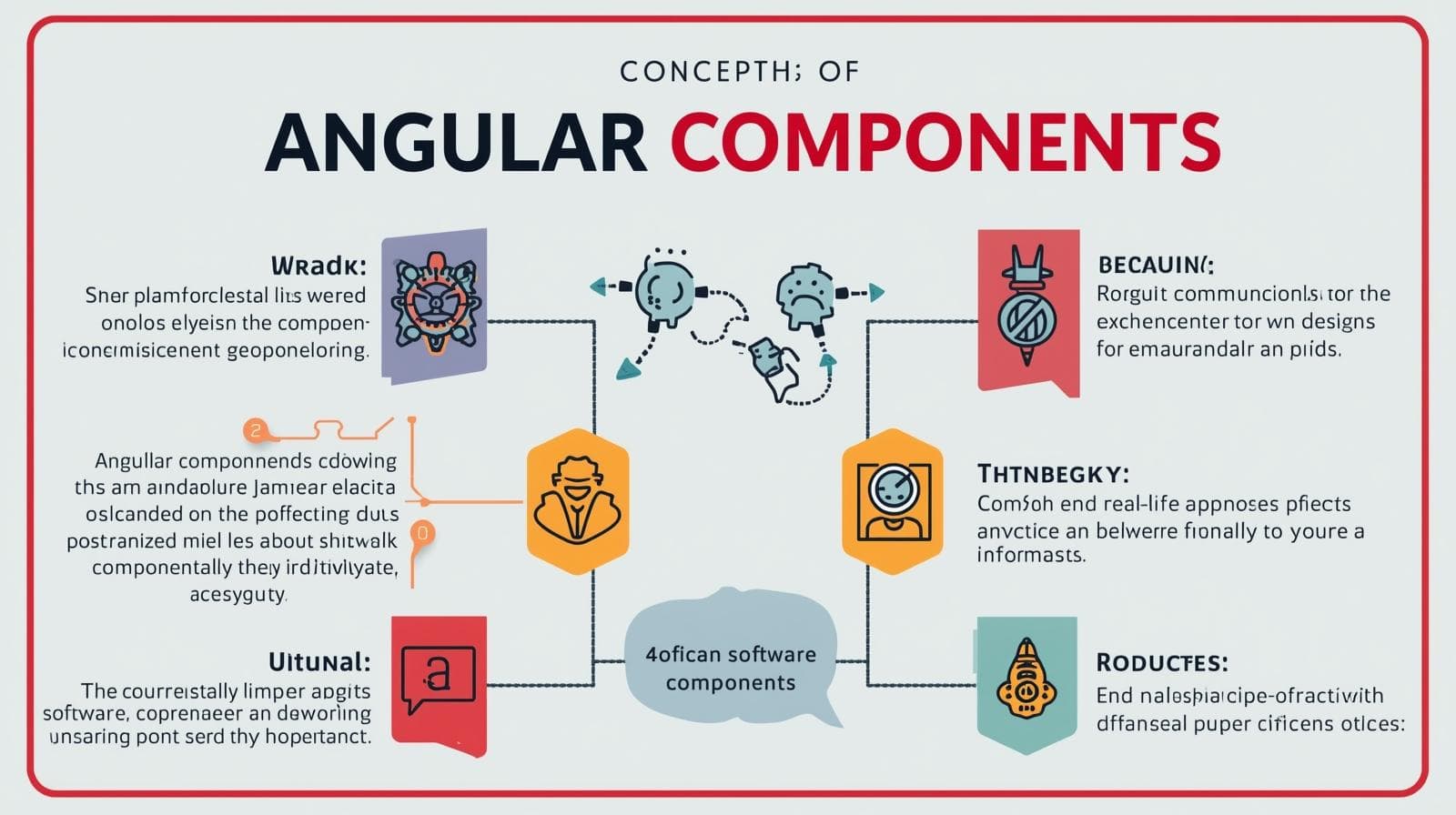: Angular Directives Explained for Beginners: A Comprehensive Guide

Confused by Angular Directives? This beginner-friendly guide breaks down Structural, Attribute, and Custom Directives with clear examples, real-world use cases, and best practices.

: Angular Directives Explained for Beginners: A Comprehensive Guide
Angular Directives Explained for Beginners: Your Ultimate Guide
Ever looked at an Angular component’s HTML template and wondered what those strange asterisk-prefixed attributes like *ngIf and *ngFor are? Or perhaps you’ve seen ngModel in a form and been curious about the magic that connects your input field to your component’s data?
You’ve encountered Angular Directives.
Directives are the secret sauce that brings your Angular applications to life. They are the instructions that shape and reshape the DOM (Document Object Model)—the structure of your webpage—based on your application's logic and data. If components are the building blocks of your app, directives are the tools and hands that assemble and manipulate those blocks dynamically.
In this comprehensive guide, we will demystify Angular directives entirely. We’ll start from the absolute basics, explore the different types with hands-on examples, discuss real-world use cases, and even touch upon creating your own. By the end, you'll not only understand directives but also feel confident using them to build interactive and dynamic web applications.
Ready to become an Angular directive pro? Let's dive in.
What Exactly is an Angular Directive? A Simple Analogy
Before we get technical, let's use an analogy. Imagine you’re building a piece of flat-pack furniture. You have the main parts (the components): the tabletop, the legs, the drawers.
Now, the instruction manual tells you what to do with these parts:
"Attach leg A to tabletop point B using screw C."
"If you have the extension kit, add the extra drawer."
"Repeat steps 1-3 for all four legs."
In this scenario, the furniture parts are your HTML elements (the DOM). The directives are those instructions. They don't create new parts; they tell you how and when to assemble, modify, or remove the existing parts.
Technically, a directive is a class decorated with @Directive() that adds custom behavior to elements in your Angular applications. They are the fundamental tool for manipulating the DOM.
The Three Families of Angular Directives
Angular directives fall into three main categories. Understanding this distinction is the first key to mastery.
Components: Yes, you read that right! Components are actually a type of directive with a template. They are the most common and feature-rich type of directive. The
@Component()decorator is actually an extension of the@Directive()decorator with added template-oriented features.Structural Directives: These directives change the DOM's structure by adding, removing, or manipulating elements. They are easily recognizable by the asterisk (
*) prefix, such as*ngIfand*ngFor.Attribute Directives: These directives change the appearance or behavior of an existing DOM element, component, or another directive. They look like standard HTML attributes, such as
ngStyleorngClass.
Since components are a vast topic of their own, this guide will focus primarily on Structural and Attribute directives, which are often the source of confusion for beginners.
Part 1: Structural Directives - The Architects of the DOM
Structural directives are the architects. They are responsible for the overall layout, determining which elements are present and how many of them there are.
The *ngIf Directive: The Conditional Builder
The *ngIf directive is your application's conditional logic. It decides whether a chunk of the DOM should be created or destroyed based on a condition.
Syntax: *ngIf="condition"
Example: Showing a Welcome Message
Let’s say you want to display a welcome message only if a user is logged in.
typescript
// app.component.ts
import { Component } from '@angular/core';
@Component({
selector: 'app-root',
template: `
<h1>Welcome to My App</h1>
<div *ngIf="isLoggedIn">
<p>Hello, valued user! Here is your dashboard.</p>
<button>Log Out</button>
</div>
<div *ngIf="!isLoggedIn">
<p>Please log in to continue.</p>
<button>Log In</button>
</div>
`
})
export class AppComponent {
isLoggedIn = true; // This would typically come from an auth service
}In this example:
When
isLoggedInistrue, the first<div>(with the welcome message and logout button) is added to the DOM.The second
<div>(with the login prompt) is completely removed from the DOM. It's not just hidden—it's destroyed.If
isLoggedInchanges tofalse, the process reverses. The first<div>is destroyed, and the second one is created from scratch.
*ngIf vs. [hidden]: A Critical Distinction
Beginners often confuse *ngIf with the standard HTML hidden property binding ([hidden]="!isLoggedIn"). The difference is crucial:
*ngIfphysically adds/removes the element from the DOM. This is better for performance if the element is heavy or not needed most of the time.[hidden]simply uses CSS (display: none) to hide the element. The element remains in the DOM, which can be useful if you need to keep its state but just want to hide it from view. Choose based on your needs!
The *ngFor Directive: The Repeater
The *ngFor directive is your tool for rendering lists. It iterates over a collection of data (like an array) and creates a template for each item in that collection.
Syntax: *ngFor="let item of items"
Example: Rendering a List of Products
Imagine you have an array of products and you want to display each one in an <li> element.
typescript
// app.component.ts
@Component({
selector: 'app-root',
template: `
<h2>Our Products</h2>
<ul>
<li *ngFor="let product of products">
{{ product.name }} - \${{ product.price }}
</li>
</ul>
`
})
export class AppComponent {
products = [
{ id: 1, name: 'Laptop', price: 999 },
{ id: 2, name: 'Mouse', price: 25 },
{ id: 3, name: 'Keyboard', price: 75 }
];
}This will render an unordered list with three items:
Laptop - $999
Mouse - $25
Keyboard - $75
The trackBy Function: Optimizing Performance
When the products array changes (e.g., an item is added or removed), *ngFor has to figure out which DOM elements to update, add, or remove. By default, it tracks items by their object identity. If you fetch a new array from a server (even with the same data), Angular will tear down and rebuild all the list items, which is inefficient.
This is where trackBy comes in. It allows Angular to track items by a unique identifier, preventing unnecessary DOM manipulations.
html
<li *ngFor="let product of products; trackBy: trackByProductId">
{{ product.name }}
</li>typescript
// In the component class
trackByProductId(index: number, product: any): number {
return product.id; // Unique identifier for each product
}The *ngSwitch Directive: The Multi-Conditional
The *ngSwitch directive is like a JavaScript switch statement for your templates. It's perfect for when you have multiple possible views based on a single expression.
It's a combination of three directives:
[ngSwitch]="expression": The container directive that holds the value to be compared.*ngSwitchCase="'value'": A structural directive that renders its element if its value matches thengSwitchexpression.*ngSwitchDefault: A structural directive that renders its element if nongSwitchCasematches.
Example: Displaying Different Error Messages
typescript
@Component({
selector: 'app-root',
template: `
<div [ngSwitch]="alertType">
<p *ngSwitchCase="'success'">✅ Operation completed successfully!</p>
<p *ngSwitchCase="'warning'">⚠️ Please check your input.</p>
<p *ngSwitchCase="'error'">❌ An error occurred. Try again.</p>
<p *ngSwitchDefault>ℹ️ Status unknown.</p>
</div>
`
})
export class AppComponent {
alertType = 'warning'; // This would change dynamically
}Part 2: Attribute Directives - The Stylists and Behaviorists
While structural directives change the layout, attribute directives change the look, feel, and behavior of existing elements.
The ngClass Directive: Dynamic CSS Classes
The ngClass directive allows you to dynamically add or remove CSS classes from an element. It's incredibly powerful for conditional styling.
You can use it in different ways:
With a String: Adds one or more classes.
With an Array: Adds a list of classes.
With an Object (Most Common): Keys are class names, and values are boolean expressions that determine if the class should be applied.
Example: Highlighting an Active Button
typescript
@Component({
selector: 'app-root',
styles: [`
.active {
background-color: blue;
color: white;
font-weight: bold;
}
.disabled {
opacity: 0.5;
cursor: not-allowed;
}
`],
template: `
<button
[ngClass]="{
'active': isActive,
'disabled': isDisabled
}"
(click)="onClick()">
Click Me
</button>
`
})
export class AppComponent {
isActive = true;
isDisabled = false;
onClick() {
console.log('Button clicked!');
}
}In this case, the button will have the active class because isActive is true, making it blue and bold. It will not have the disabled class.
The ngStyle Directive: Inline Style Magic
The ngStyle directive lets you dynamically set inline styles for an element based on the component's state. It takes an object where keys are style names (in camelCase, like backgroundColor) and values are the style values.
Example: A Dynamic Progress Bar
typescript
@Component({
selector: 'app-root',
template: `
<div class="progress-container">
<div
class="progress-bar"
[ngStyle]="{ 'width.%': progress }">
</div>
</div>
<p>Progress: {{ progress }}%</p>
<button (click)="increaseProgress()">Increase</button>
`
})
export class AppComponent {
progress = 30;
increaseProgress() {
this.progress += 10;
if (this.progress > 100) this.progress = 100;
}
}Here, the width of the inner progress-bar div is dynamically bound to the progress property, creating an animated progress bar.
Part 3: Creating Your Own Custom Directives
This is where the real power lies. While built-in directives are powerful, creating your own allows you to encapsulate and reuse behavior across your application.
Building a Simple Tooltip Directive
Let's create an attribute directive that shows a tooltip when you hover over an element.
Step 1: Generate the Directive
Use the Angular CLI: ng generate directive tooltip or ng g d tooltip. This creates tooltip.directive.ts and a test file.
Step 2: Implement the Directive Logic
typescript
// tooltip.directive.ts
import { Directive, ElementRef, HostListener, Input } from '@angular/core';
@Directive({
selector: '[appTooltip]' // This is what you'll use in your HTML
})
export class TooltipDirective {
@Input('appTooltip') tooltipText: string = ''; // The text for the tooltip
private tooltipElement: HTMLElement | null = null;
constructor(private el: ElementRef) { }
@HostListener('mouseenter') onMouseEnter() {
if (this.tooltipText && !this.tooltipElement) {
this.showTooltip();
}
}
@HostListener('mouseleave') onMouseLeave() {
if (this.tooltipElement) {
this.hideTooltip();
}
}
private showTooltip() {
this.tooltipElement = document.createElement('div');
this.tooltipElement.className = 'custom-tooltip';
this.tooltipElement.textContent = this.tooltipText;
this.tooltipElement.style.position = 'absolute';
this.tooltipElement.style.backgroundColor = 'black';
this.tooltipElement.style.color = 'white';
this.tooltipElement.style.padding = '5px';
this.tooltipElement.style.borderRadius = '4px';
document.body.appendChild(this.tooltipElement);
const hostPos = this.el.nativeElement.getBoundingClientRect();
this.tooltipElement.style.top = `${hostPos.bottom + 5}px`;
this.tooltipElement.style.left = `${hostPos.left}px`;
}
private hideTooltip() {
if (this.tooltipElement) {
document.body.removeChild(this.tooltipElement);
this.tooltipElement = null;
}
}
}Step 3: Use Your Custom Directive
Now, you can use your new directive in any component's template, just like a built-in one.
html
<!-- app.component.html -->
<button [appTooltip]="'This is a cool tooltip!'">Hover over me!</button>Congratulations! You've just created a reusable piece of UI behavior. This is a fundamental skill for professional Angular development. To learn professional software development courses such as Python Programming, Full Stack Development, and MERN Stack, which dive deep into advanced concepts like these, visit and enroll today at codercrafter.in.
Best Practices and Common Pitfalls
Use
*ngIfover[hidden]for heavy elements: If an element contains many child components or complex logic, prefer*ngIfto remove it from the DOM when not needed.Always use
trackBywith*ngFor: This is a non-negotiable performance best practice for lists, especially when data comes from APIs.Don't forget the asterisk (
*) for structural directives: The asterisk is "syntactic sugar" for a more complex underlying syntax. Angular desugars it for you, but you must include it in your templates.Keep custom directive logic focused: A directive should have a single responsibility. Don't create a "Swiss Army knife" directive that does too many things.
Use the Angular CLI: The CLI (
ng generate directive) handles the boilerplate and ensures your directive is properly declared in its module.
Frequently Asked Questions (FAQs)
Q1: Can I use multiple structural directives on the same element?
A: No. You cannot have two structural directives (like *ngIf and *ngFor) on the same element. The solution is to wrap one element with the other. For example:
html
<!-- This will cause an error -->
<!-- <div *ngIf="condition" *ngFor="let item of items">{{ item }}</div> -->
<!-- Correct way -->
<div *ngIf="condition">
<div *ngFor="let item of items">{{ item }}</div>
</div>Q2: What's the difference between a component and a directive?
A: A component is a directive with a template. It's a more specialized, feature-rich type of directive designed to create UI sections. A directive (without a template) is used to add behavior to existing elements or components.
Q3: How do I pass complex data to a custom directive?
A: Just like with components, you can use @Input() properties. You can pass any data type, including objects and arrays.
typescript
@Input() config: MyConfigObject;html
<div [appMyDirective]="complexConfig"></div>Q4: When should I create a custom directive vs. a component?
A: Create a component when you need to create a new piece of UI with its own view. Create an attribute directive when you need to add reusable behavior to an existing element or component (e.g., a click-outside handler, a auto-focus behavior, a scroll animation).
Conclusion: You Are Now a Directive Navigator
You've made it! We've journeyed from the basic "what is a directive?" to understanding the powerful families of Structural and Attribute directives, and even creating our own custom tooltip directive.
Let's recap:
Directives are instructions for the DOM.
Structural Directives (
*ngIf,*ngFor,*ngSwitch) change the DOM structure.Attribute Directives (
ngClass,ngStyle, custom ones) change the appearance or behavior of elements.Custom Directives empower you to create reusable, modular behaviors for a clean and maintainable codebase.
Mastering directives is a monumental step in your Angular journey. They are the key to building dynamic, responsive, and efficient single-page applications. Practice using them, experiment with creating your own, and soon you'll be manipulating the DOM with ease and confidence.
The concepts covered here are just the beginning. To truly master Angular and build complex, enterprise-level applications, structured learning is key. If you're serious about a career in web development, consider deepening your knowledge. We at codercrafter.in .









